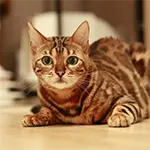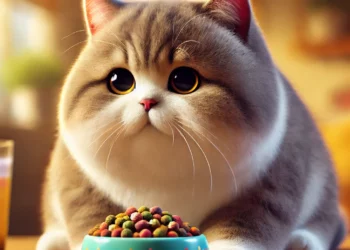The Bengal cat is a striking breed known for its exotic appearance, resembling a miniature leopard. With its distinct markings and energetic personality, this breed has captured the hearts of cat enthusiasts worldwide. This article explores the history, characteristics, and care requirements of the Bengal cat, providing valuable insights for current and prospective owners.
History and Origin
The Bengal cat was first bred in the United States in the 1960s by crossing domestic cats with the Asian leopard cat (Prionailurus bengalensis). The aim was to combine the wild look of a leopard with the temperament of a house cat. This breeding experiment successfully created a domestic cat with rosette spots and a wild appearance but with the affectionate and playful nature expected of a pet. The breed gained popularity in the 1980s and has since been recognized by major cat associations, including The International Cat Association (TICA).
Physical Characteristics
Bengal cats are medium to large in size, weighing between 8 to 15 pounds (3.6 to 6.8 kilograms). They are known for their muscular build and sleek bodies, which contribute to their agility and athleticism. Their most notable feature is their short, dense coat that comes in a variety of colors and patterns. The most common pattern is the spotted or rosette pattern, giving them the appearance of a wild leopard. Bengals can also have marbled coats, showcasing a unique swirl pattern.
Their coat has a luxurious, soft texture and often exhibits a glittery sheen that adds to their allure. Eye color can range from green and gold to striking blue in snow-colored Bengals.
Personality and Temperament
Bengal cats are highly intelligent and energetic. They are known for their playful, inquisitive nature and thrive in environments where they can explore, climb, and engage with toys or interactive activities. These cats are also social and form strong bonds with their human families, often following them around the house and participating in daily activities. Bengals are vocal and expressive, using a range of sounds to communicate their feelings and needs.
While they are affectionate, Bengal cats retain a level of independence, making them ideal for owners who appreciate an active and interactive pet. They can coexist well with children and other pets when socialized properly from a young age.
Care and Maintenance
Caring for a Bengal cat requires attention to both its physical and mental needs:
- Diet: Bengals benefit from a high-protein diet that supports their muscular build and active lifestyle. This can include high-quality wet or dry cat food, and some owners opt for a raw diet after consulting a veterinarian.
- Exercise: These cats need daily stimulation and exercise to stay healthy and happy. Play sessions involving interactive toys, laser pointers, and puzzle feeders are ideal for keeping them entertained.
- Grooming: Although their short coats are low maintenance, brushing them once a week helps remove loose hair and maintain the coat’s health and shine.
- Environment: Bengals need a stimulating environment filled with cat trees, shelves, and interactive toys to satisfy their climbing instincts and prevent boredom.
Health and Longevity
Bengal cats have a lifespan of 12 to 16 years when well cared for. They are generally healthy but can be prone to certain genetic conditions such as:
- Hypertrophic Cardiomyopathy (HCM): A heart disease that is common in many cat breeds.
- Progressive Retinal Atrophy (PRA): An eye condition that can lead to vision loss.
- Patellar Luxation: A condition that affects the knee joint and can lead to mobility issues.
Regular veterinary check-ups and preventive health care are essential to catch any potential health issues early and ensure the long-term well-being of a Bengal.
Fun Facts and Trivia
- The Bengal cat’s name is derived from the scientific name of the Asian leopard cat, Prionailurus bengalensis.
- Bengals are one of the few cat breeds that enjoy playing in water.
- Their glittery coat effect is due to the translucent tips of the hair, creating a unique shine under the light.
- The Bengal is one of the most popular cat breeds in the world, often featured in shows for its striking appearance and playful demeanor.
Comparing the Bengal to Other Breeds
When compared to other exotic cat breeds like the Savannah or the Ocicat, the Bengal stands out for its combination of a wild appearance and a highly social personality. While the Savannah is known for its height and serval lineage, the Bengal remains smaller but boasts a more diverse range of coat colors and patterns. The Ocicat, which is also spotted, lacks the wild lineage but is similarly intelligent and active.
FAQs
Are Bengal cats good with families?
Yes, Bengal cats can be excellent companions for families. They are social, playful, and form strong bonds with their human family members. They can get along well with children and other pets if properly socialized.
Do Bengal cats shed a lot?
Bengal cats have a short, dense coat that sheds less compared to many other breeds. Weekly brushing helps to keep shedding minimal and maintains the health of their coat.
Are Bengal cats hypoallergenic?
While no cat breed is truly hypoallergenic, Bengal cats may produce fewer allergens due to their short coat and lower shedding. However, individuals with cat allergies should spend time with a Bengal before bringing one home to assess their reaction.
Do Bengal cats require a lot of attention?
Yes, Bengals are highly active and intelligent cats that require significant attention and engagement. They thrive in environments where they have access to interactive play and mental stimulation.
Can Bengal cats be left alone for long periods?
Bengals do not do well when left alone for extended periods. They require social interaction and mental stimulation to prevent boredom, which can lead to destructive behavior.










